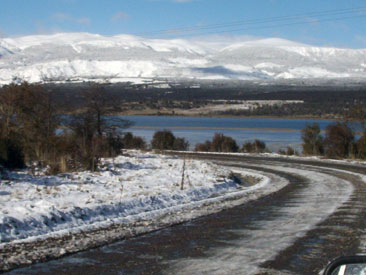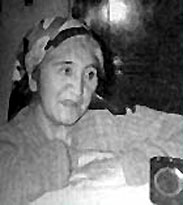Colony Lago Rosario See map
"Memorias de Humo": a simple project, a transcendent work, a story of belonging and displacement Mapuche.
This is the story of Lago Rosario, a small rural settlement located within the city of Trevelin, at the foot of the Patagonian Andes in the province of Chubut. A story that begins with the banishment.
 Lake Rosario semi frozen and snowy mountains. Photo courtesy of Christian H. Casco.
Lake Rosario semi frozen and snowy mountains. Photo courtesy of Christian H. Casco.By the late nineteenth century, hundreds of families araucano crossed the Andes, down south in search of land to occupy a strip of land whose ownership was disputed between Argentina and Chile.
As it was happening in Argentina's Patagonia, where the army directed by Julio A. Roca was displacing the aboriginal settlements from their homes on behalf of the Conquest of the Desert, also the government of Santiago de Chile pursued and confronted with the Mapuche settlements whose members were forced, also by force, to withdraw into the mountains and even crossing over South (provinces of Neuquen and Río Negro) to continue the search for a new destination.
1902 Referendum
The beginning of the twentieth century finds several of those Aboriginal families, already scattered in their membership in groups or tribes, occupying lands in the vicinity of the "Colonia 16 de Octubre", which is located in one of these fertile and beautiful valleys of Patagonian Andes, at the then National Territory of Chubut.
On April 30, 1902 the inhabitants of this colony (mostly of Welsh descent) participated in a referendum by which the governments of Argentina and Chile (represented by the Perito Francisco Moreno and Dr. Balmaceda respectively) resolved the border dispute that remained in that region, which was refereed by the British Crown with the representation of Sir Thomas Holdich.
The resolution of the border dispute caused many Chilean families who lived in the Argentine side and whose sovereignty was confirmed by the referendum, decided to return to their country by crossing the border again.
The process of crossing the border over and over went on, however, for several years and decades. Some families had even opted to stay in Argentine territory and claim the land as the inmigrants who came from Europe did then.
Those who stayed
 Margarita Cheuquehuala and her experiences in Lago Rosario.
Margarita Cheuquehuala and her experiences in Lago Rosario.Such is the case of families Millahuala and Cheuquehuala which in 1930 had long inhabited the valley located on the banks of a lake full of legends, stories and myths.
"Lago Rosario" was the name that the first territorial governor of Chubut, Luis Jorge Fontana, gave in 1885. But the place was already its history.
In the lake nest the dreaded "leather" and "Mermaid." Until there came the tehuelches to hunt wild cattle and they used to pray next to a rock on which the sun glinted of blood as an augury of good hunting. There is still heard in the nights of rain, the tehuelche hunter's lament dead gored by the last wild bull, or "Toro de Agua", as it is recalled.
Determined to settle down with their children born in that place, the Cheuquehuala and Millahuala built a school in 1934 and asked the Argentine government to appoint a teacher. From Buenos Aires it was respond to them that will have a teacher when people representing a total of 25 children.
As an irony of fate, the same government of Buenos Aires in 1937 determined the removal of Aboriginal Reserve Nahuel Pan, about thirty kilometers north of Lago Rosario, where more than 300 people, children, adults and elders, were banished after thirty years of living there, a land given in 1908 by the same government that now cast into the wilderness or the best to their own devices.
This fact led to several displaced families, particularly those with children, being accepted in Lago Rosario. It did well to gather the required number of students so that Buenos Aires sent finally a teacher. The arrival of this mark the first official state presence in Lago Rosario, and therefore the recognition of people who lived there.
Viajes por la Patagonia
Related Articles
© Patagonia.com.ar 2025 | Todos los derechos reservados.
